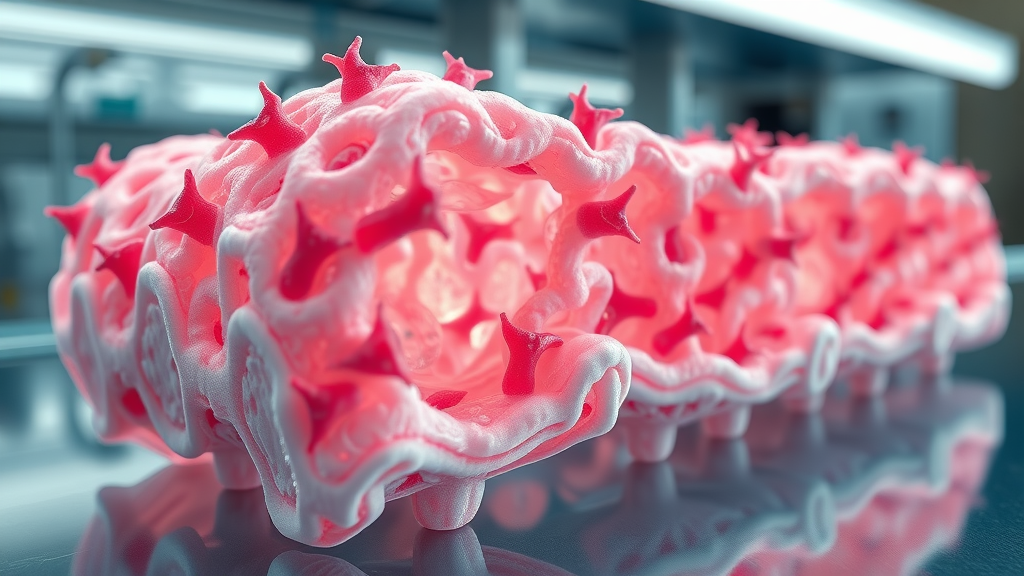Imagine a world where the human body repairs itself from within—where instead of managing disease, we foster true recovery. Recent projections reveal the global regenerative medicine market is expected to exceed $150 billion by 2030—an extraordinary leap, underscoring the dramatic transformation this field is bringing to modern healthcare. But what exactly are regenerative therapies, and why is their promise so profound? Read on as we unravel how these innovative approaches could rewrite your healing journey forever—and why experts believe now is the time to pay attention.
Amazing Advances in Regenerative Therapies: Why the Hype Is Justified
- Recent data shows the global regenerative medicine market is projected to surpass $150 billion by 2030. Explore why regenerative therapies are fast becoming the backbone of advanced healthcare—and how they can change your healing journey.

The field of regenerative therapies is advancing at an unprecedented pace, propelling a global transformation in how medicine approaches lifelong healing. Once deemed the stuff of science fiction, treatments like stem cell therapy, tissue engineering , and cell therapy are now redefining possibilities for patients who previously faced limited prospects. Experts predict these methods will touch nearly every aspect of healthcare by the next decade, from orthopedics to neurology, enabling physicians to go beyond symptom management and actually promote tissue repair and regeneration.
For instance, stem cell therapies allow clinicians to harness a patient’s own biological materials to address the root causes of damaged tissues and chronic conditions, aiming for a return to normal function. This paradigm shift means people struggling with long-term injuries, degenerative diseases, or even organ damage may soon benefit from approaches that amplify the body’s natural healing process, offering the hope of true restoration instead of just temporary relief. With continuous investments in clinical trials and biotechnology, the hype surrounding regenerative medicine is more than justified—it’s the beginning of a new era in medical science.
What Regenerative Therapies Are and How They Revolutionize Medicine
- Definitions and Core Principles of Regenerative Therapies
- The Founding Concepts of Regenerative Medicine
- The Role of Natural Healing and Tissue Repair
- Growth Factors and Their Influence in Regenerative Therapies
Regenerative therapies represent a groundbreaking medical approach centered on restoring, replacing, or repairing damaged tissues and organs to regain normal function. Unlike conventional treatments that often focus on management or symptom alleviation, these innovative solutions address the underlying causes of dysfunction, leveraging advanced strategies from stem cell therapy and cell therapy to tissue engineering and gene therapy . At their heart, regenerative medicine practices aim to activate or enhance the body’s own natural healing process , transforming chronic or untreatable illnesses into manageable or even curable conditions.
Core principles fueling the success of regenerative medicine include harnessing the power of various cell types —such as mesenchymal and pluripotent stem cells —to replace or rejuvenate damaged tissue . Additionally, the application of growth factors and platelet-rich plasma can accelerate tissue regeneration by signaling cells to repair or develop new healthy structures faster than natural healing alone would allow. By working at the cellular and molecular level, these therapies push the boundaries of what’s possible in treating trauma, degenerative diseases, and congenital defects.
Thus, the field of regenerative medicine is nothing short of revolutionary: It leverages biological building blocks and the body's self-repair mechanisms to pave the way for treatment strategies that could permanently transform both the landscape of healthcare and the lives of millions.
What You'll Gain from This In-depth Guide to Regenerative Therapies
- A clear understanding of how regenerative therapies work for long-term healing
- Insight into state-of-the-art techniques including stem cell therapy, tissue engineering, and cell therapy
- Key answers to common questions like the four types of regenerative medicine and challenges faced
- Practical advice to evaluate if regenerative therapies might aid your own health goals
This guide demystifies the science and practice of regenerative therapies , empowering you with knowledge about the mechanisms, major types, and the clinical breakthroughs making headlines today. Whether you’re exploring options for chronic pain, looking to understand advanced healing for orthopedic injuries, or simply curious about the latest in medical technology , you’ll find comprehensive, actionable answers here. By tackling both the promise and the challenges of the field, you’ll leave with a foundation to discuss these therapies with confidence—whether with your healthcare provider or as you navigate your own health journey.
You’ll also gain updated insights on the latest clinical trials, tissue engineering advances, stem cell applications, and regulatory issues facing modern practitioners. Finally, this guide offers practical advice so you can determine if these breakthrough approaches may suit your unique wellness goals or conditions, making you an informed participant in the evolving world of regenerative medicine.
Key Types and Modalities: Stem Cell Therapy, Tissue Engineering, and Cell Therapy
Stem Cell Therapy: The Cornerstone of Regenerative Therapies
- Types of Stem Cells Used (Embryonic, Adult, Induced Pluripotent)
- Stem Cell Therapy for Tissue Repair and Damaged Tissue
At the epicenter of regenerative medicine is stem cell therapy , lauded for its ability to stimulate tissue repair and potentially cure diseases previously deemed irreversible. Stem cells—remarkable due to their capacity to differentiate into any cell type in the body—can be categorized as embryonic, adult (such as bone marrow-derived), and induced pluripotent . These unique cells are harvested and guided to replace or repair damaged tissues , accelerating recovery and making durable healing possible for conditions ranging from musculoskeletal injuries to neurological disorders.
The versatility of stem cells lies in their ability to integrate into existing tissue structures, orchestrate the regeneration of damaged tissue , and promote efficient, natural healing. By enabling minimally invasive solutions such as direct injections into injured joints or organs, patients can experience improved outcomes, reduced recovery periods, and sometimes even avoid more complex surgical procedures altogether. The ongoing development and refinement of stem cell therapy has solidified it as the backbone of the regenerative revolution sweeping the world’s leading clinics.

Cell Therapy: Harnessing the Power of Specialized Cells for Regeneration
- How Cell Therapy Accelerates Tissue Regeneration
- Examples of Cell Therapies Used in Clinical Trials
Cell therapy employs a deliberate infusion or transplantation of living, specialized cells to rejuvenate and replace cells that are lost due to injury, disease, or age-related decline. Distinct from general tissue transplants, these therapies use carefully selected cells—including immune cells, chondrocytes, or genetically-modified cells—to aggressively target damaged tissue and facilitate regeneration. In many instances, cell therapies are tailored to a patient’s unique biology, driving personalized medicine to new heights and offering an unprecedented level of specificity in tissue regeneration .
Current clinical trials in the field of regenerative medicine explore everything from CAR-T cell therapies for cancer to chondrocyte-based treatments for joint repair and platelet-rich plasma injections for accelerated recovery. These advances not only prove the robustness of targeted cell therapies , but also open possibilities for expanding treatment options in chronic, difficult-to-treat conditions. The emphasis on safety, efficacy, and standardized methods is helping to drive cell therapy forward as a cornerstone of regenerative options available to clinicians and patients alike.
Tissue Engineering and Growth Factor Applications in Regenerative Therapies
- Principles Behind Tissue Engineering and Its Integration with Regenerative Therapies
- Use of Growth Factors and Platelet Rich Plasma for Enhanced Healing
Tissue engineering merges the principles of material science, engineering, and cell biology to create functional tissues and, potentially, entire organs. By combining scaffolds—three-dimensional structures that support the growth and development of new cells—with potent growth factors and living cells, researchers can cultivate replacement tissues outside the body and then implant them as needed. This approach has transformative potential for patients requiring complex reconstructive procedures, such as the repair of large bone defects or damaged cartilage.
The use of platelet-rich plasma (PRP) and other concentrated growth factors is rapidly gaining popularity. These biologics are harvested from a patient’s blood and reintroduced to injury sites, catalyzing a faster and more robust healing response. Unsurprisingly, an increasing number of clinical trials are evaluating how growth factor therapies —in concert with tissue engineering —can shorten the recovery window for everything from sports injuries to cardiovascular ailments. The synergy between these techniques offers new hope for restoring function and quality of life in challenging clinical settings.
| Therapy Type | Core Features | Common Uses | Notable Clinical Examples |
|---|---|---|---|
| Stem Cell Therapy | Use of pluripotent or multipotent stem cells for tissue repair | Joint injuries, neurodegenerative disorders, cardiac repair | MSC injections for osteoarthritis, neural stem cells for spinal cord injury |
| Cell Therapy | Transplantation of specialized or genetically-modified cells | Cancer treatment, tissue regeneration, autoimmune diseases | CAR-T therapy for leukemia, chondrocyte injections for cartilage repair |
| Tissue Engineering | Lab-grown tissues/organs using scaffolds and growth factors | Organ repair, reconstructive surgery, burn/wound healing | Engineered skin grafts, 3D-printed cartilage scaffolds |
| Gene Therapy | Genetic modification to stimulate or suppress tissue responses | Inherited diseases, tissue restoration, cancer research | Gene editing for sickle cell anemia, CRISPR therapies |

A Deep Dive into Regenerative Medicine and Its Expanding Applications
- The Wide Range of Diseases and Conditions Supported by Regenerative Medicine
- Current Clinical Trials and Research on Regenerative Therapies
- Breakthroughs in Tissue Engineering for Orthopedics, Cardiology, Neurology
The field of regenerative medicine is versatile, supporting a wide range of conditions—spanning from orthopedic injuries and chronic wounds to heart disease and neurodegeneration. As ongoing clinical trials continue to break new ground, advanced tissue engineering and cell therapies are being refined to meet highly specific patient needs. Orthopedic research, for example, is already demonstrating how engineered cartilage and bone tissues can restore function in patients with severe trauma, while breakthroughs in cardiac repair and neurology point to a future where heart attack and spinal cord injury survivors regain lost abilities.
Current research also shows rapid expansion into autoimmune diseases, diabetic complications, and even the treatment of burns or chronic skin injuries. By accelerating tissue repair and facilitating the direct replacement of damaged tissues , regenerative therapies are rewriting the prognosis for diseases once considered hopeless. The persistent dedication of regenerative medicine experts and biotechnological innovators continues to push barriers—ensuring tomorrow’s breakthroughs are closer than ever before.
Notably, the convergence of different techniques—such as combining gene therapy with tissue engineering or leveraging multiple cell types in joint therapies—is catalyzing faster success in clinical trials and expanding the broader impact of regenerative science across medical specialties.
The Science Behind Regenerative Therapy: Damaged Tissue Repair and Natural Healing
- The Biological Mechanism: How Stem Cells and Growth Factors Heal Damaged Tissue
- Case Studies: Regenerative Therapies in Action
The scientific foundation of regenerative therapy rests on the body’s innate capacity for self-repair. When tissues are injured, growth factors, stem cells, and supporting cells coordinate the complex healing process . Modern therapies leverage theses mechanisms at an amplified scale: biologists isolate and concentrate stem cells , infuse growth factors (such as from platelet-rich plasma ), or implant engineered tissue scaffolds, boosting the speed and reliability of natural recovery. For example, in patients with osteoarthritis, injecting stem cells directly into joints cultivates new cartilage and limits inflammation, offering sustainable improvements in mobility and quality of life .
Real-world clinical trial evidence provides striking proof of efficacy. Stroke survivors have regained lost capabilities; cardiac patients have seen damaged heart muscle partially restored; and athletes have overcome chronic ligament injuries without surgery, thanks to advances in tissue engineering and cell-based strategies.
“Regenerative therapies offer hope where conventional treatments can only manage symptoms. Our cells hold nature’s code for self-repair.” — Dr. Alicia Kim, Regenerative Medicine Specialist

Navigating the 4 Main Types of Regenerative Medicine Explained
- Stem Cell Therapy
- Tissue Engineering
- Gene Therapy
- Cell Therapy (Including Platelet-Rich Plasma)
The four main types of regenerative medicine driving medical innovation are stem cell therapy, tissue engineering, gene therapy, and cell therapy (including platelet-rich plasma approaches). Stem cell therapy is transformative due to its multipotent nature, facilitating tissue repair and replacement in a minimally invasive manner. Tissue engineering focuses on constructing living tissues using biocompatible materials as scaffolds, primed for integration upon implantation.
Gene therapy modifies or replaces defective genes, aiming to directly correct causes of genetic disease or enhance the body’s natural healing response. Finally, cell therapy —the targeted administration of specialized cells—encompasses a variety of individualized treatments, including platelet-rich plasma , to stimulate rapid tissue regeneration and repair. Each method complements the others, allowing clinicians to tailor strategies for a wide range of medical needs.
Challenges and Limitations of Regenerative Therapies
- Key Barriers: Cost, Accessibility, and Clinical Trial Standardization
- Debates on Efficacy and Long-term Safety
- Regulatory and Ethical Considerations Surrounding Stem Cell and Gene Therapy
"Perhaps the biggest hurdle for regenerative medicine is demonstrating consistent outcomes in diverse patient populations." — Dr. Daniel Franco, Cellular Therapy Expert

Despite its promise, the field of regenerative medicine faces significant obstacles. The high cost of therapies, limited insurance coverage, and rigorous requirements for clinical trials and standardization contribute to accessibility issues. While the range of offered therapies is growing, demonstrating reproducible and safe outcomes in diverse populations remains a persistent challenge. Regulatory authorities, especially in the context of stem cell and gene therapy , maintain stringent oversight to ensure patient safety and long-term data collection, prompting ongoing debate within the research community.
Questions about the ultimate efficacy and potential side effects, such as immune reactions or tumor formation, remain under investigation in long-term studies. Ethical issues—ranging from embryonic stem cell sourcing to genetic modification—are hotly debated among scientists, policymakers, and the public. Until these concerns are resolved, regenerative therapy will continue to operate at the intersection of hope, innovation, and caution.
Who Can Benefit from Regenerative Therapies? A Wide Range of Applications
- Chronic Pain, Orthopedic Injuries, Neurodegenerative Diseases
- Cardiac Repair, Diabetes, Skin and Tissue Regeneration
Regenerative therapies are showing tremendous benefit for patients with chronic pain, orthopedic injuries (like tendonitis or cartilage loss), and neurodegenerative diseases such as Parkinson’s or ALS. People suffering from heart failure and those requiring cardiac repair after a heart attack have also seen improved outcomes with regenerative approaches. Additionally, tissue regeneration methods are being explored to heal diabetic ulcers, support limb salvage, and restore function after major trauma or burns.
Skin and hair restoration, dental applications, and even interventions for autoimmune illnesses are among the wide range of conditions being addressed through ongoing development and refinement. With progress accelerating in laboratory studies and clinical trials worldwide, more individuals will find themselves eligible for these transformative therapies in the coming years.
The Future of Regenerative Therapies: Innovations and What’s Next
- Emerging Trends: 3D Printed Tissues, Personalized Medicine, and AI in Tissue Engineering
- Long-Term Potential for Broader Accessibility

The future of regenerative therapies is brighter than ever, with rapidly emerging trends poised to increase the effectiveness, personalization, and availability of advanced treatments. Three-dimensional bioprinting of tissues and organs using patient-derived cells, machine learning algorithms for optimizing tissue engineering designs, and custom gene editing are reshaping what was once the domain of science fiction. These innovations point to a future where patients may one day receive organs built from their own cells, eliminating the risk of rejection and long waiting lists for transplants.
As techniques advance and regulatory frameworks evolve, broad accessibility to regenerative therapy is becoming more realistic. Advances in scalability, cheaper production methods, and digital health platforms mean a wider segment of the population will soon have access to life-changing healing possibilities. The next decade promises unprecedented improvements in quality of life, disease management, and preventive care for people worldwide.
People Also Ask
What is an example of a regenerative therapy?
- An example of regenerative therapy is stem cell therapy, where stem cells are injected into damaged tissue—like cartilage in joints—to stimulate natural healing and regeneration.
What are the 4 types of regenerative medicine?
- The four main types are stem cell therapy, tissue engineering, gene therapy, and cell therapy, each focused on leveraging biological materials or cells to foster regeneration.
What is the biggest problem with regenerative medicine?
- One of the biggest problems is the lack of long-term data from clinical trials to substantiate safety, efficacy, and affordability of these therapies.
What are the 5 regenerative medicine?
- Counting core branches, the five often-referenced regenerative medicine approaches include stem cell therapy, tissue engineering, gene therapy, platelet-rich plasma therapy, and cellular therapies.
Frequently Asked Questions About Regenerative Therapies and Regenerative Medicine
-
What conditions qualify for regenerative therapy?
Regenerative therapies are being used for orthopedic conditions (like joint injury and arthritis), neurodegenerative diseases, cardiac repair post-heart attack, chronic wounds, and immune-mediated conditions. Eligibility depends on diagnosis and evaluation by specialized clinicians. -
How long does it take to see results from regenerative medicine?
The time to see results varies based on the condition and therapy used. Some patients experience improvement within weeks, especially with platelet-rich plasma or certain cell therapies, while others, such as tissue engineering, may require several months for noticeable healing. -
Is regenerative therapy approved by the FDA?
While select therapies (such as specific autologous stem cell treatments and CAR-T cell therapies) are FDA-approved, many remain investigational and are offered only through clinical trials. Patients should consult healthcare providers for up-to-date status of their treatment of interest. -
Are there any side effects associated with cell therapy or stem cell therapy?
Most reported side effects are mild and may include swelling, mild pain at the injection site, or short-term immune responses. Rare severe reactions are possible, especially if cells are not properly matched or therapies are not standardized, highlighting the need for expert oversight. -
How does tissue engineering fit into regenerative therapies?
Tissue engineering creates new tissues or organs in the lab by combining scaffolds, cells, and growth factors. These engineered tissues are then implanted into patients to repair or replace areas of damage, synergizing with other regenerative therapies for optimal healing.
Key Insights and Action Steps
- Regenerative therapies represent a new paradigm for healing. Whether through stem cell therapy, tissue engineering, or emerging cell therapies, the field is rapidly expanding with remarkable possibilities.
- Evaluating risks and benefits with a healthcare professional is crucial for informed decision-making.
Let Us Guide Your Healing Journey Toward Advanced Regeneration
- Reach out to request your complimentary health screening. Call us now at 2816988698
Regenerative therapies are revolutionizing healthcare by harnessing the body’s natural healing processes to repair or replace damaged tissues and organs. These innovative treatments, including stem cell therapy, tissue engineering, and gene therapy, offer promising alternatives to traditional medical approaches.
For instance, stem cell therapy involves using pluripotent or multipotent stem cells to stimulate tissue repair, offering potential cures for previously irreversible conditions. Tissue engineering combines scaffolds, cells, and biologically active molecules to create functional tissues that can replace or repair damaged areas, particularly significant in organ transplants where donor organs are scarce. Gene therapy introduces, removes, or alters genetic material within a patient’s cells to treat or prevent disease, enhancing the regenerative capacity of cells. ( stemcellcouncil.com )
However, it’s important to note that while regenerative medicine holds great promise, safety and effectiveness can vary based on the therapy or product. The FDA has approved treatments using cells derived from blood or bone marrow due to well-established safety and efficacy. Yet, therapies derived from patients’ fat cells are often marketed based on limited evidence, and very few regenerative medicine therapies have been adequately tested for effectiveness. ( pewtrusts.org )
In summary, regenerative therapies represent a transformative shift in medical science, aiming to restore function and improve quality of life by leveraging the body’s inherent healing abilities. As research progresses, these therapies may become integral to treating a wide range of conditions, offering hope for patients worldwide.
 Add Row
Add Row  Add
Add 

Write A Comment